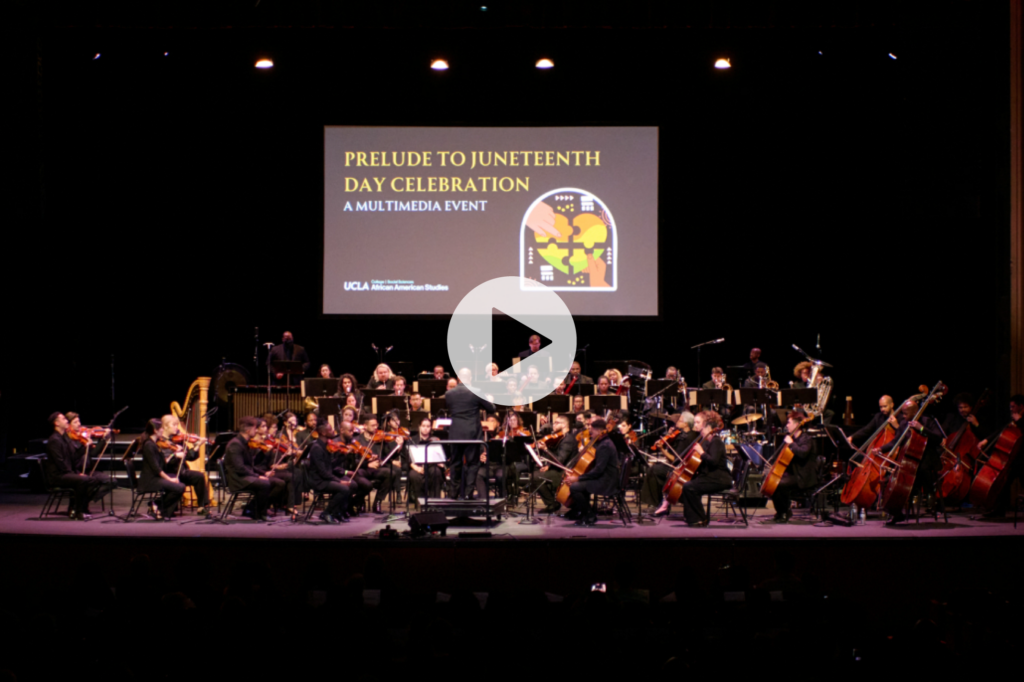Cheryl L. Keyes, professor of ethnomusicology and global jazz studies and chair of the African American studies department, was recently awarded the silver medal in the Global Music Awards for her “Sundiata Keita Overture.” The overture received its world premiere in Royce Hall on June 5 during a multimedia event, “Prelude to Juneteenth.”
Keyes’s “Sundiata Overture” tells the story of Sundiata Keita (Soon-JA-ta Kae-EE-ta), the founder of the Malian Empire in the thirteenth century. We sat down with Cheryl Keyes to talk about her inspiration for the overture.
* * *
Where did you first encounter the story of Sundiata Keita?
After graduating from Jacobs School of Music [at Indiana University-Bloomington], I pursued my doctorate degree in Folklore-Ethnomusicology there. I always wanted to study music of the African Diaspora, particularly of West Africa. African Americans trace their lineage to this area in Africa. I encountered Sundiata when studying Bambara, which was my second language for my Ph.D.
Bambara was the language in Mali?
Yes, it was the lingua franca for that region. I studied African folklore as part of my Ph.D. training, and that was where I first encountered the Epic of Sundiata Keita. In West Africa, Sundiata’s story was told by the “griot” or bards, in English, “jeli” or “jeliw” in Bambara. They are the ones who celebrate his legacy through the oral tradition, even today.
I came across the Epic while studying Bambara, because the teachers were familiar with Sundiata’s legacy. Sundiata is known as the founder of the Mali Empire (c. 1217). Keita is the surname inherited by those from the royal family. Last names mean something in Africa. I visited Mali, West Africa [as part of my Ph.D. training] really wanting to study the women bards, rather than the men, and it ended up becoming the beginning of my understanding the elements of poetic nuance and the role of the word and language and meaning and power as it traveled across the Atlantic [with the African diaspora] and continues to permeate and transform into other traditions and newer forms that is a continuum of West African aesthetic practices.
So, the griot tradition gets carried on in African American culture?
Yes, it gets carried through a number of different forms, for instance: the traditional sermon, preaching as we call it; the blues, which is a form of lyrical poetry. With the migration of Blacks from the US South to urban centers in the North as well as those immigrants from the Caribbean, all of these genres or practices become repositories of many contemporary traditions today like MCing and DJing known popularly as rap music or hip hop. I discussed this in my book, Rap Music and Street Consciousness.

Your Sundiata Overture has a very distinctive theme. How did you compose it?
I carried that melody with me for a long time. It first came to me, in parts, when I was in graduate school. The story was inspiring and heroic.
The melody has been in your head since graduate school?
Yes! It’s gone through many iterations. If you are talking about influences, one influence is the African musical tradition and improvisation. And when I’m talking about improvisation, I want to reference Alvin Batiste, who was the jazz clarinetist and educator at Southern University, an HBCU in Baton Rouge. We called him “Mr. Bat.” Mr. Bat was known for using perfect fourths. So, when I thought of the Sundiata theme, I carried this influence with me.
Film music also influenced my aesthetic choices. Composers like John Williams and the great Bernard Herrmann, who scored a lot of the Hitchcock films.
So, you imagined this as a heroic story, a heroic theme?
If I were ever asked to compose a film score of Sundiata’s epic, my overture could definitely serve as a template. There are three themes in the Sundiata Overture. The first theme is called the “gait,” because Sundiata was born physically challenged. But when he began to walk, he had a distinctive gait. The clarinets, trombones, tuba, and bassoon capture the melo-rhythmic groove, prior to the melody performed by the strings.
There is some interesting instrumentation as well. Does this trace back to African roots?
One does hear instruments emulating two of those performed by griot musicians of Mali and translated by instruments in a traditional orchestra: the kora, which is a harp-lute is performed by the harp, and the balafon, which sounds like and is performed similarly to the marimba.
In the epic, Sundiata’s and his family are forced into exile by his nemesis, Sumamuru, king of the Susu people. The second theme in my overture is called “in a pensive state,” and is about Sundiata’s exile period in which he strategizes how to recapture Mali from the clutches of Sumamuru. The third theme is called “victory dance” celebrating Sundiata’s triumph and return to Mali, signified by the intro melody of the balafon, which was Sumamuru’s instrument, whom Sundiata overthrew.
What are your future plans for the Sundiata Overture?
Well, given that the world premiere of Sundiata Keita Overture just won a silver medal from the Global Music Awards, I remain hopeful that it will be performed by more orchestras across the world. Sundiata is an important epic, especially because it demonstrates just how deep the cultural roots of African Americans really are.
